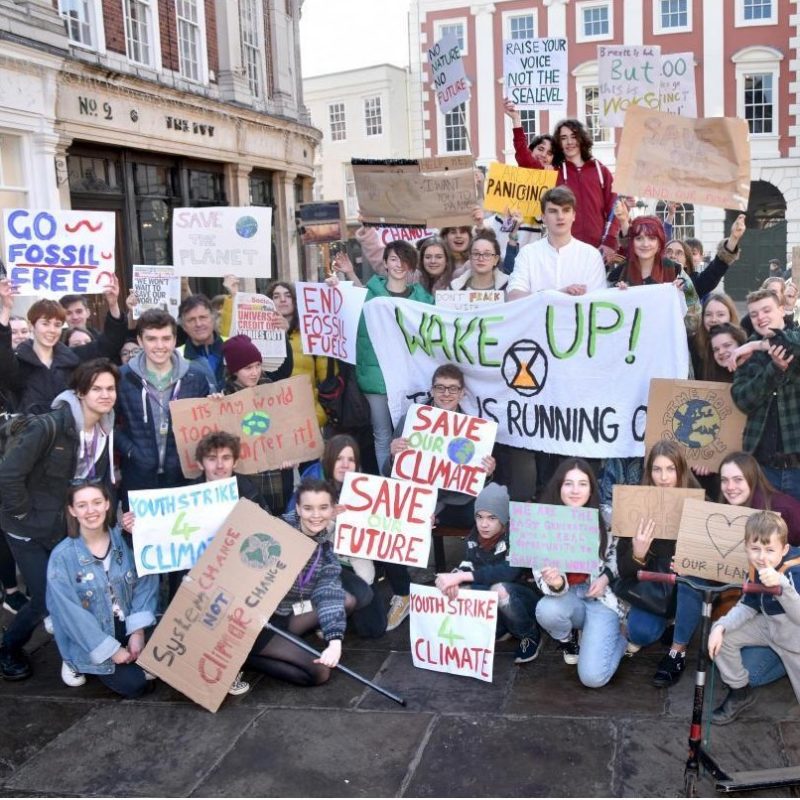
Three years ago, to loud applause from the public gallery, York City Council unanimously declared a Climate Emergency and committed itself to the ‘target of making York carbon neutral by 2030.’ It was not, however, until June this year that the Council released a draft Climate Change Strategy. How then does this stack up against the bold commitments made back in 2019?
The Council’s Head of Carbon Reduction, Shaun Gibbons, offered to meet a small group of local Labour Party members in July to answer that question and a number of other carbon-related queries. Here is what we found out.
What is the goal?
The simple graph below, taken from the slide deck Shaun presented in our Zoom session, sets out what the strategy proposes.
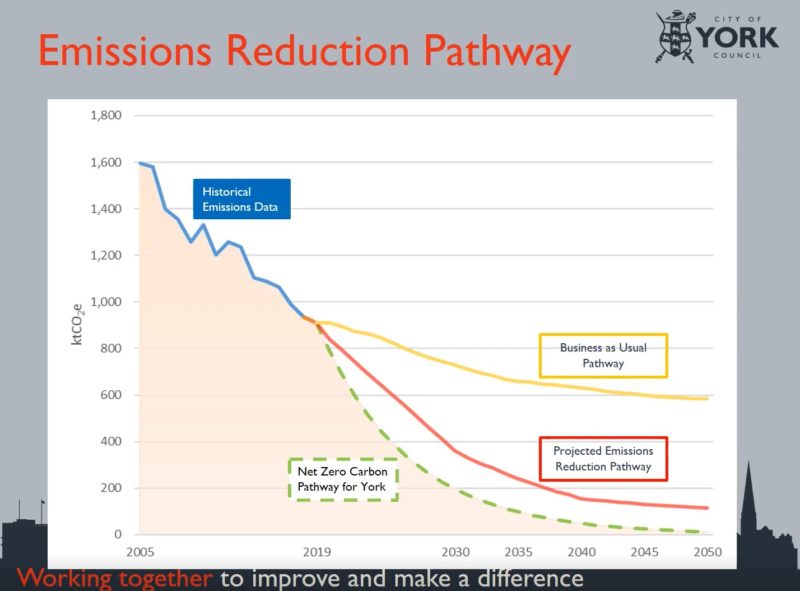
It shows a 39% emissions reduction between 2005 and 2018 due to a combination of increasingly decarbonised electricity supply, structural change in the economy, and the gradual adoption of more efficient buildings, vehicles and businesses.
The graph then traces three potential pathways:
- The yellow line is Business as Usual, i.e., what would happen if the City continued on its current track and did nothing more to cut carbon.
- The red line is the Projected Emissions Pathway, or what the authors of the strategy are confident can be achieved with currently known and available policy mechanisms, funding, technology and capacity.
- The green dotted line is the Net Zero Carbon Pathway and the stated ambition which is consistent with the recommendations in the Paris UN Agreement.
To quantify the differences between these paths, it is important to note that the graph takes as its starting point the year 2005 and, thus, any percentage reductions refer back to emissions in that year. So, by 2030, the red pathway results in reductions of 77% from the 2005 baseline, while the green path (Paris) leads to a fall of 88%.
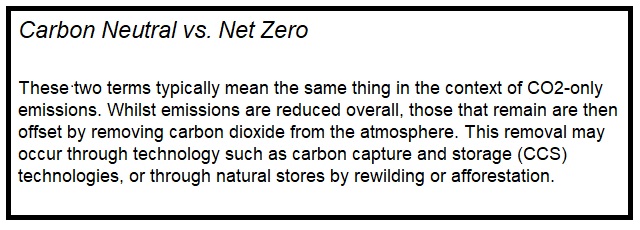
The Projected Emissions Reduction Pathway is clearly out of line with Net Zero Carbon Pathway and would not keep York within the carbon budget necessary to avoid 1.5° C heating. Moreover, neither pathway achieves carbon zero by 2030; indeed, the red line does not even get there by 2050. The obvious question is, ‘Why not?’
‘We can only deliver what is available to us right now.’ replies Shaun. ‘However, we can set the ambition to go further where possible. There is a performance gap, but the ambition is still to follow the green line. Technical innovation, stimulating supply chains, changes in national policy and funding could all bring us closer. ‘
He adds that offsetting will also need to be part of the solution
The Strategy’s Executive Summary puts it this way.
‘If we do all we can with the currently available options, we will reduce emissions by 77% by 2030; but we will need to go further – through new scientific endeavour, making the most of emerging technology, lobbying for and embracing policy change, attracting external investment, and working together across the city to take every advantage we can.’
We were keen to know, however, what these currently available options are that the Strategy claims would prevent the City meeting the 2030 target.
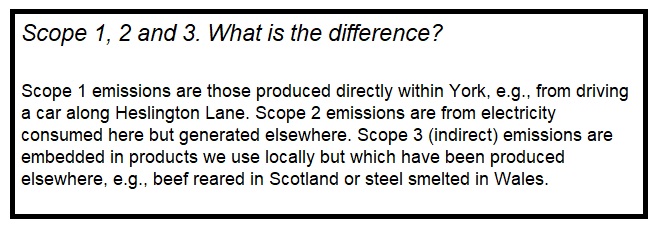
Shaun referred to data scaled down from carbon totals calculated at a national level using an information tool called SCATTER. This will be made available in a technical annex to the Strategy, but he emphasised that the SCATTER data is quite technical and not easy for a lay person to follow.
How do we get there?
For those who might struggle with SCATTER, another way to get an insight into the boundaries within which the Strategy works is to look through the table it provides of ‘Where we are’ and ‘Where we need to be.’ An initial Action Plan has also been made public, though this only covers a period of about eighteen months. The challenge has been made that there is a need for a lengthier and more detailed ‘road map,’ like that produced by the authorities in Sunderland and Nottingham.
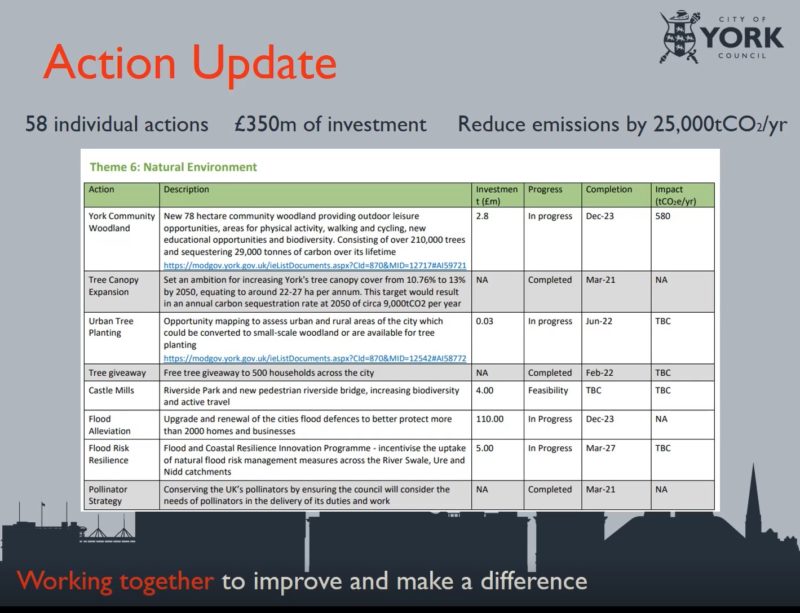
Shaun’s response is that the Strategy needs to span multiple administrations and it is for each Executive to set its own action plan.
‘The action plan would have a shorter timeframe and would be subject to the priorities of the current administration. It could be revised annually to reflect manifesto commitments but would always need to be aligned with strategic priorities.’
Are all emissions included?
A vital element in the priorities set is the range of emissions the Strategy includes. The Climate Emergency Declaration promised that the 2030 target would ‘take into account both production and consumption emissions (Scope 1, 2 and 3).’ However, the Strategy acknowledges that it ‘does not currently include our indirect emissions.’ It was pointed out that the Council itself is, in fact, well-placed to reduce Scope 3 emissions through choices it makes about purchasing or building projects. Shaun’s response was that there was not a reliable way of assessing indirect emissions, but that the strategy commits us to a ‘better understanding’ of Scope 3.
Is there joined-up thinking?
The Climate Strategy is only one of a number of plans the Council is currently drafting. Strategies for Economic Development and Health and Wellbeing are also currently out for consultation and all three documents will go before the Executive in October. What mechanisms are, therefore, in place to ensure the climate reduction strategy underpins all Council decisions? Shaun’s reply is that the intention is for there to be alignment across all three strategies.
‘We have looked at the proposal that all medium and large-scale projects have a carbon impact assessment. We would like to give carbon literacy training for anyone responsible for such projects.’
Do we need more money?
The thorny question of finance was then raised. Was the £100,000 cut that had been made to carbon reduction funding covered by additional funds from other sources, as the Executive Member for Transport had claimed.
Shaun stated this had been more than covered by, for example, £1.3 m from Forestry England. When queried whether this had been ring-fenced for forestry, he said that this was, in fact, the case but there was some flexibility.
Do we need more staff?
The final question came close to home. Would an increase in staff in the Carbon Reduction Team help in carrying the process forward? Unsurprisingly, the answer Shaun gave was ‘Yes.’ This would allow the team to give support to other departments, he explained, and to bid for more funding, an endeavour in which they had already demonstrated success. Moreover, this might allow them to extend the scope of their work to, for example, adaptation to climate change, an area which so far had been restricted to the issue of flooding.
The strategies for Climate Change, Health and Well-being and the Economy can be accessed here. The three strategies will go before the Council Executive on October 8th. Details are here.

